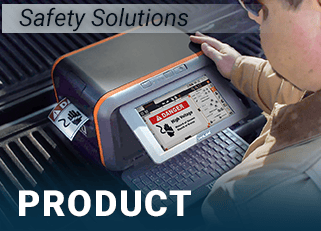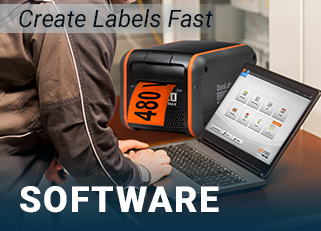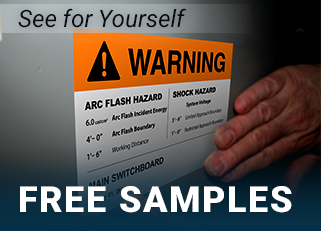Ammonia Refrigeration System Fundamentals
03
February,
2023
4 MINUTE READ

Artificial cooling systems keep industry running, and many of these systems use anhydrous ammonia as a refrigerant. How do these ammonia refrigeration systems work? What are the hazards of ammonia refrigeration, and what can be done to keep workers safe?
Ammonia Refrigeration Systems 101
Refrigeration systems use basic physics to move heat energy out of one area and into another, leaving the first area cooler than it was before. The refrigerator in your kitchen does this to keep the milk from going bad. Indoor ice hockey rinks and grocery store freezer sections use the same process on a larger scale. Massive industrial facilities like petrochemical refineries and food processing plants rely on large-scale refrigeration systems for their day-to-day operations.
The most common type of refrigerating system is a vapor-compression refrigerator. This approach uses a fluid called a refrigerant as the means of moving heat around. Most of the time, the refrigerant is a vapor. At one point in the system, it's compressed to become a liquid; later, it's allowed to expand and vaporize again. The process repeats on a cycle. Each time the refrigerant vaporizes, it absorbs heat energy from its surroundings, and each time it condenses, it releases that heat to its new location.
The physical properties of the refrigerant determine the pressure and temperature ranges of the system, along with the rate of cycling required for a given cooling effect. In turn, those details determine the efficiency of the refrigeration system as a whole. The choice of refrigerant is important, and many synthetic materials have been created for the purpose. Famously, many chlorofluorocarbons (CFCs) such as Freon-12 were developed and widely used during the 20th century, until their destructive impact on the environment was discovered.
Why Ammonia Refrigeration?
In very large cooling systems, like those in food processing facilities, ammonia is a common choice of refrigerant. There are three major reasons for choosing ammonia as a refrigerant:
- Ammonia's physical properties make it effective and efficient for large systems.
- It breaks down quickly in the environment, minimizing potential environmental impact.
- Any spill or accidental release can be quickly identified, because of ammonia's strong odor.
According to the International Institute of Ammonia Refrigeration (IIAR), ammonia is 3 to 10% more thermodynamically efficient than competitive refrigerants. This allows an ammonia-based refrigeration system to achieve the same cooling effect while using less power. As a result, where ammonia refrigeration is appropriate, it can offer lower long-term operation costs.
Ammonia breaks down in the environment very quickly (lasting less than a week in the air). Unlike synthetic refrigerants like CFCs, it doesn't damage the ozone layer. Most of ammonia's potential for harm relies on there being too much of it in one place, not on its being leaked and scattered into the environment. In fact, ammonia is often sprayed on fields as a fertilizer in industrial farming.
Finally, most people will notice the pungent smell of ammonia when it's only about 20 parts per million (ppm) in the air. While some refrigerants have no noticeable smell, allowing small leaks to go unnoticed, that's not the case with ammonia. Even a tiny amount in the air will be obvious. Importantly, the detectable concentration is much lower than the concentration that will cause immediate harm.
Dangers of Ammonia Refrigeration
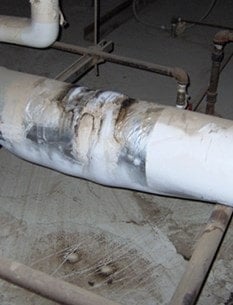
Because ammonia's properties are best suited to large refrigeration systems, there is likely to be a large amount of ammonia in any system that uses it. Any water in the system would freeze and obstruct piping, so ammonia refrigeration systems must use anhydrous ammonia (without water or other impurities). The physics of vapor-compression refrigeration require the system to use enough pressure to compress the gas into a liquid. Together, this means the refrigeration system uses a large amount of pure ammonia under high pressure.
As a result, any ammonia-based refrigeration system is going to present a risk of accidental exposure to high concentrations of ammonia. That kind of accident could cause serious harm to human health.
OSHA considers anhydrous ammonia to be "immediately dangerous to life and health" at a concentration of 300 parts per million (ppm), or 0.03%. Ammonia is corrosive to the skin, eyes, and lungs, and even a brief exposure can result in severe chemical burns. Extreme cases can even kill the victim. In a 2006 accident in a food processing facility, a pipe fitting broke during maintenance and sprayed nearby workers at short range. One worker died and another was hospitalized. Read more ammonia safety and health information from OSHA.
Preventing an Ammonia Leak
OSHA recommends, among other steps, conducting a process hazard analysis (PHA) when ammonia refrigeration is present in a workplace. A PHA consists of a careful review of potential problems-such as an ammonia leak-and what steps should be taken to prevent such an outcome. Conducting this analysis may raise awareness among employees, promote a mindful attitude about safety, and engender a proactive approach to hazard and risk assessment.
Requirements for PHAs can be found in 29 CFR 1910.119, OSHA's standard for Process Safety Management of Highly Hazardous Chemicals.
A PHA should include the following:
- Identify any hazards of the process.
- Identify any previous incidents that could have had potentially catastrophic consequences in the workplace.
- Outline any engineering and administrative controls that can be taken to lessen risks associated with the hazard.
- Break down the consequences should any engineering and/or administrative controls fail.
- Address any potential safety and health effects on employees in the event of failure.
Conducting a PHA is a key component of broader process safety management efforts. Read more about process safety management.
Ammonia Refrigeration System Safety
The risks involved with ammonia refrigeration can be reduced substantially by careful management and maintenance. Part of that process is clear labeling of the pipes and equipment being used. As the accepted industry experts in this field, the IIAR maintains a code of recommendations for refrigeration equipment labeling.
Last updated in April 2014, IIAR Bulletin No. 114 specifies sizes, colors, and arrangements for ammonia pipe and component labels. This coherent system simplifies maintenance and promotes safety, and is compatible with ANSI/ASME A13.1, the most widely-used industrial standard for general facility pipe marking.
There are five elements in a typical ammonia pipe marker:
- Piping abbreviation, such as "LTRS" for Low Temperature Recirculated Liquid, to identify the part of the system that the pipe represents
- Physical state of the pipe's contents, shown with letters on a colored band: "LIQ" on yellow, for liquid; "VAP" on sky blue, for vapor; or both, if the pipe could contain both phases
- Pipe contents, simply and clearly indicated with the word "Ammonia"
- Pressure level, shown with letters on a colored band: "LOW" on green, for contents at 70 psig or less; or "HIGH" on red, for contents above 70 psig
- Flow direction, indicated with an arrow pointing along the pipe in the correct direction
Ammonia Refrigeration System Label Requirements
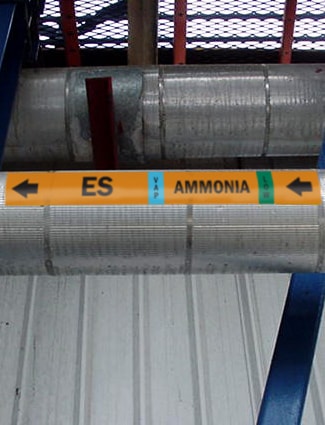
The piping abbreviation, pipe contents, and flow direction would be shown in black print on an orange background. Under the popular ANSI/ASME A13.1 pipe marking standard, that is the preferred presentation for pipes carrying toxic contents, such as ammonia. As a result, a pipe marker that matches IIAR Bulletin No. 114 also matches the broader standard.
This comprehensive, industry-specific labeling system needs to be used consistently for the best results. Duralabel offers an ammonia pipe marking reference chart describing the IIAR's system. Using this chart can help your facility maximize its safety and efficiency, while you take advantage of the power of ammonia refrigeration. Begin addressing hazards with IIAR standards with our free Pipe Marking chart.
RELATED RESOURCES

How to Meet IIAR Standards for Ammonia Pipe Marking
For safe operations and maintenance, its important employees know what's inside the pipes they're working ...
Read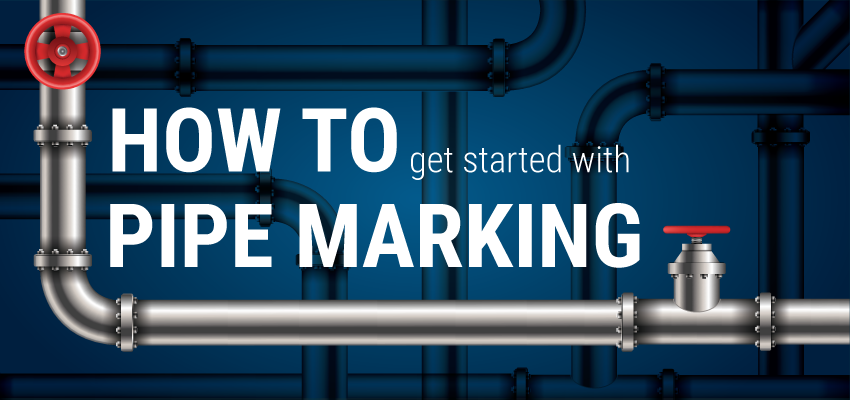
How to Get Started with Pipe Marking & Labeling
Pipe marking quickly communicates information about a pipe and its contents, improving overall workplace ...
Read
ASME A13.1 | Pipe Marking Guide | ANSI Pipe Labeling |
Pipe marking quickly communicates essential information to everyone in a facility, improving overall ...
Read.png)
